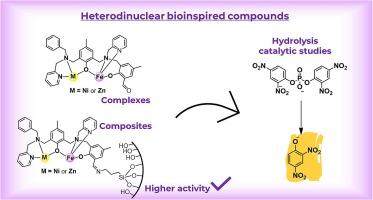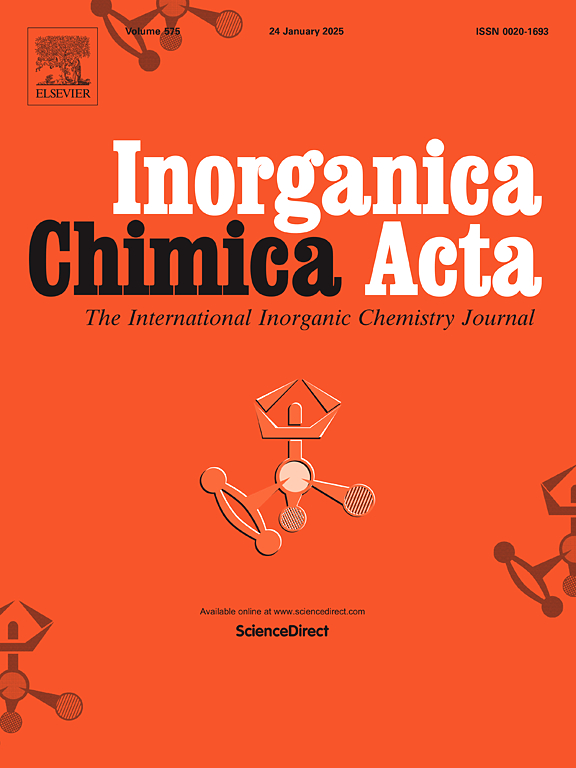生物启发的 FeIIINiII 和 FeIIIZnII 复合物及其 3-aminopropyl 硅复合材料的选择性类似二酯酶的活性:同质和异质催化研究
IF 2.7
3区 化学
Q2 CHEMISTRY, INORGANIC & NUCLEAR
引用次数: 0
摘要
在这项研究中、制备和表征了两种新的混价异核配合物[FeIIINiII(BPPAMFF)(μ-OAc)2(H2O)]ClO4 (1)和[FeIIIZnII(BPPAMFF)(μ- OAc)2(H2O)]ClO4 (2)。OAc)2(H2O)]ClO4(2)的生物启发配体 2-[(N-苄基-N-2-吡啶基甲基胺)]-4-甲基-6-[N-(2-吡啶基甲基)氨基甲基)])-4-甲基-6-甲酰基苯酚(H2BPPAMFF)。将这些化合物固定在 3-氨基丙基二氧化硅(APS)中,成功地得到了 APS-1 和 APS-2 复合物。含醛配体提供了一个活性官能团,可作为交联基团将复合物结合到直接氨基修饰的二氧化硅表面。傅立叶变换红外光谱、紫外可见光光谱和电子发射光谱等光谱技术对 APS 无机平台上的配合物的化学完整性进行了探测。电位滴定法和分光光度滴定法使溶液中存在的化学物质更加合理,并确定了其中哪些化学物质在磷酸二酯 2,4-BDNPP 的水解裂解过程中具有潜在活性。动力学研究表明,FeIIINiII 物种(1 和 APS-1)比 FeIIIZnII 物种(2 和 APS-2)具有更高的催化效率(E = kcat/KM)。根据一系列动力学实验提出了催化机制,在这些实验中,所有测试的催化剂都表现为选择性磷酸二酯酶。此外,实验还证明固定化催化中心 APS-1 和 APS-2 的水解酶活性优于均相过程,其中第二配位球效应可能参与了过渡态的引导和稳定。本文章由计算机程序翻译,如有差异,请以英文原文为准。

Selective diesterase-like activity of bioinspired FeIIINiII and FeIIIZnII complexes and their 3-aminopropyl silica composites: A homo- and heterogeneous catalytic study
In this study, the preparation and characterization of two new mixed-valence heterodinuclear complexes [FeIIINiII(BPPAMFF)(μ-OAc)2(H2O)]ClO4 (1) and [FeIIIZnII(BPPAMFF)(μ-OAc)2(H2O)]ClO4 (2) with the bioinspired ligand 2-[(N-benzyl-N-2-pyridylmethylamine)]-4-methyl-6-[N-(2-pyridylmethyl)aminomethyl)])-4-methyl-6-formylphenol (H2BPPAMFF) are reported. These compounds were immobilized in 3-aminopropyl silica (APS) to afford composites APS-1 and APS-2 successfully. The aldehyde-containing ligand provided a reactive functional group, which could serve as a cross-linking group to bind the complexes to the directly amino-modified SiO2 surface. The complexes’ chemical integrity on the APS inorganic platform were probed by spectroscopical techniques, such as FTIR, UV–Vis and EPR. Potentiometric and spectrophotometric titrations allowed the chemical species present in solution to be rationalized, and identified which of them were potentially active in the hydrolytic cleavage of phosphodiester 2,4-BDNPP. Kinetic studies showed that FeIIINiII species (1 and APS-1) presented higher catalytic efficiency (E = kcat/KM) than FeIIIZnII species (2 and APS-2). Catalytic mechanisms were proposed based on a series of kinetic experiments, in which all the catalysts tested behaved as selective phosphodiesterases. In addition, it was also demonstrated that the hydrolase activity of the immobilized catalytic centers, APS-1 and APS-2, was better than the homogeneous processes, where second coordination sphere effects may be involved in directing and stabilizing the transition state.
求助全文
通过发布文献求助,成功后即可免费获取论文全文。
去求助
来源期刊

Inorganica Chimica Acta
化学-无机化学与核化学
CiteScore
6.00
自引率
3.60%
发文量
440
审稿时长
35 days
期刊介绍:
Inorganica Chimica Acta is an established international forum for all aspects of advanced Inorganic Chemistry. Original papers of high scientific level and interest are published in the form of Articles and Reviews.
Topics covered include:
• chemistry of the main group elements and the d- and f-block metals, including the synthesis, characterization and reactivity of coordination, organometallic, biomimetic, supramolecular coordination compounds, including associated computational studies;
• synthesis, physico-chemical properties, applications of molecule-based nano-scaled clusters and nanomaterials designed using the principles of coordination chemistry, as well as coordination polymers (CPs), metal-organic frameworks (MOFs), metal-organic polyhedra (MPOs);
• reaction mechanisms and physico-chemical investigations computational studies of metalloenzymes and their models;
• applications of inorganic compounds, metallodrugs and molecule-based materials.
Papers composed primarily of structural reports will typically not be considered for publication.
 求助内容:
求助内容: 应助结果提醒方式:
应助结果提醒方式:


